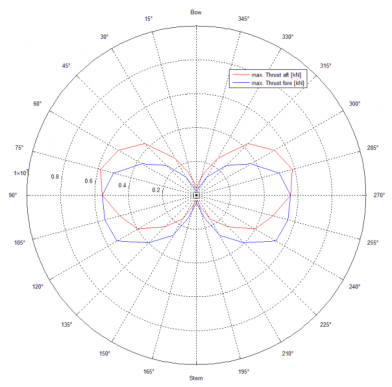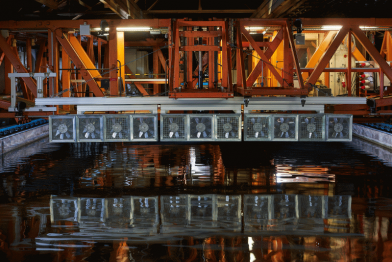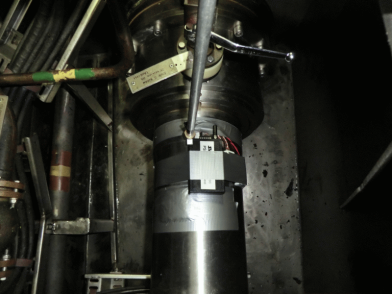
Offshore & Energy
Please read here more about seakeeping trials and numerical simulations of ships and structures in seaways.
Interpretation of DP control systems is realised through dynamic environmental conditions simulated in the towing tank with free running models. Any irregular sea state and wind profile can be produced. The model can be equipped with rudders, thrusters, VSPs and other control mechanisms. The superstructure of the ship is also modelled.
Context Related References / Research Projects
[1] Steinwand, M., Wuttke, H., Schleusener, B.: Prognose quasistationärer Rumpfkräfte anhand von Vergleichsschiffen, numerische Modellierung von Steuer- und Propulsionsorganen und Verifikation simulierter Manöver, Bericht 3735, Schiffbau-Versuchsanstalt Potsdam, November 2010 (Abschlussbericht)
[2] Steinwand, M., Schomburg, E.: 360° – Strömungskräfte auf das Schiff, STG-Sprechtag Manövrieren, 14. Mai 2014, Hamburg
[3] Steinwand, M.: Dynamic Positioning von Schiffen und Plattformen mit Motionstabilisierung unter Verwendung von x/y-Logik, 8. SVA-Forschungsforum, Potsdam, 29. Januar 2015
[4] Steinwand, M.: Forces on Podded Drives in Manoeuvring Condition, SVA-CTO-Meeting, Brieselang, 6. Juni 2015
[5] Steinwand, M.: Bestimmung der Kräfte und Momente auf das Unterwasserschiff über Anströmwinkel von360°, Bericht 4342, Schiffbau-Versuchsanstalt Potsdam, Juni 2015 (Abschlussbericht)
- Wind Forces
- Wave Forces
- Current Forces
Each of these forces is determined seperately and the total resulting force is then calculated by the principle of superpostion.
- Wind forces are calculated using empirical formulas, usually according to Blendermann [1] or Isherwood [2]. The calculation of wind forces can be carried out for any surface vessel.
- The wave forces are calculated with the program system UTHLANDE. These calculations are based on linear strip theory. The drift forces are determined for each given sea state.
- The values for current forces are obtained from the SVA’s extensive database of comparative ships. Moreover, the results come from the SVA research project “Determination of Forces and Moments on The Hull at Angles of Incidence through 360°” into the forecasting methods of SVA.
As a result, DP Capability plots come for the various scenarios and environmental conditions studied. The example below shows a single DP Capability Plot for a ship with bow and stern thrusters. The forecasting provides the needed thrusts of the particular thruster, which are necessary for the investigated combination of waves, wind and current to hold the ship in position.
Context Related References / Research Projects
[1] Blendermann, W.: Parameter Identification of Wind Loads on Ships, Journal of Wind Engineering and Industrial Aerodynamics, 51 (1994)
[2] Isherwood: Wind resistance of merchant ships, Royal Inst. of Nav. Arch., 1972
[3] Steinwand, M., Wuttke, H., Schleusener, B.: Prognose quasistationärer Rumpfkräfte anhand von Vergleichsschiffen, numerische Modellierung von Steuer- und Propulsionsorganen und Verifikation simulierter Manöver, Bericht 3735, Schiffbau-Versuchsanstalt Potsdam, November 2010 (Abschlussbericht)
[4] Steinwand, M., Schomburg, E.: 360° – Strömungskräfte auf das Schiff, STG-Sprechtag Manövrieren, 14. Mai 2014, Hamburg
[5] Steinwand, M.: Dynamic Positioning von Schiffen und Plattformen mit Motionstabilisierung unter Verwendung von x/y-Logik, 8. SVA-Forschungsforum, Potsdam, 29. Januar 2015
[6] Steinwand, M.: Forces on Podded Drives in Manoeuvring Condition, SVA-CTO-Meeting, Brieselang, 6. Juni 2015
[7] Steinwand,M.: Bestimmung der Kräfte und Momente auf das Unterwasserschiff über Anströmwinkel von 360°, Bericht 4342, Schiffbau-Versuchsanstalt Potsdam, Juni 2015 (Abschlussbericht)
On Board Measurements
Performance measurements on the propeller shaft are performed during measured miles, acceptance of new ships and, in case of problems, in the area of propeller/engine tuning to determine the power consumption of the propeller at full-scale. For this, the torque and speed of the propeller shaft or gear coupling shafts and intermediate shafts are measured. The torque measurement is carried out with strain gauges and the speed measurement with a magnet-hall sensor system. With a Bluetooth measurement module, the signals are processed and transmitted digitally to a measuring computer. Additional metrics like speed, heading, rudder angle and trim of the vessel may be time equidistantly recorded. For this purpose, GPS / DGPS systems, gyroscopes and other instrumentation are available.
Prior to delivery and acceptance of new ships, the achievable speed for a given power and the power consumption for a given speed is determined in a trial (measured mile) with the full-scale version. Primarily, it is checked as to whether the contractual parameters have been achieved and, secondarily, whether the required EEDI is fulfilled.
To determine the delivered power, the torque and rotational velocity of the propeller for a given speed can be measured. This measurement can be carried out by the SVA onboard the ship with own measurement equipment.
Unlike model tests, the conditions in a measured mile are only in the rarest cases ideal. It can hardly be avoided that measured miles must be carried out in wind and waves, with shallow water effects, in areas of current, etc. To convert the environmental influences on the contract or experimental conditions, the measured mile results must be evaluated. The SVA Potsdam offers such calculations which are performed in accordance to the current standards of IMO and ITTC.


